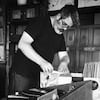In the late ‘40s, Columbia Records attempted to corner the market on the sale of recorded music by introducing the long-playing album—those 12-inch wonders that could be filled with songs and played back at 33⅓ revolutions per minute. Worried about losing its market share, rival label RCA responded with the extended play 45, known as the EP—a 7-inch single that boasted at least two songs per side and was often packaged in pairs in gatefold sleeves.
While the dynamics of the LP have remained pretty much constant to this day, the EP has been something of a shape-shifter, evolving from a simple repackaging of singles by popular acts for fresh sales and chart placements into a way for artists like Pavement and The Pretenders to release a small batch of new material without the pressure of filling out a whole album.
Or as Spoon’s Britt Daniel puts it in his foreword for the recently published book An Ideal for Living: A Celebration of the EP – Extended Play (Hozac Books, 202 pages, $25.99): “The EP is a musical sweet spot where you can be on your own…secure in the knowledge that what you’re making is just for you and those who love you enough to follow you anywhere.”
This new tome was conceived and overseen by Corey duBrowa, a former Portland resident and longtime music journalist. Like his friend Daniel, he’s been similarly obsessed with the format ever since purchasing a copy of the debut EP by New Wave paragons Oingo Boingo back in 1980.
“The EP was sort of the musical Goldilocks,” duBrowa says, speaking from his home in Bend. “Not too hot, not too cold. It wasn’t a single, it wasn’t an LP. It was something in between. To me, the EP was this happy middle ground.”
An Ideal for Living (named after Joy Division’s 1978 debut EP) came to life after duBrowa began researching the origins of the EP online and found the available information lacking. Opting to tell the story himself, he put together what he calls a “graduate school paper” that became the first chapter of the book. As he told Hozac when presenting his initial findings, “You know rock critics love a good list, so I think what I should do is compile a list of the greatest EPs ever and I’ll bring a bunch of friends into that discussion.”
That list of pals included acclaimed journalists Annie Zaleski and WW contributor Jason Cohen, Bratmobile drummer Molly Neuman, and filmmaker Nickolas Rossi, among many others, all of whom contributed to the book. With their help, duBrowa was able to consider dozens of EPs released from the ‘50s to today and shape the final chapter running down the 25 best EPs of all time. The finished list is impressively catholic, including releases by Elvis Presley, enigmatic dubstep producer Burial, Ice Cube, and Pink Floyd.
As with all music books of its ilk, An Ideal for Living is going to delight and frustrate readers, starting as many arguments as it serves to settle. I’ll give it points for declaring Slates, the 1981 six-song release by post-punk geniuses The Fall, to be an EP despite the insistence of the band’s members that it is a “mini-album,” but I deduct an equal amount for leaving out 1994′s Archers of Loaf vs. The Greatest of All Time, my favorite piece of wax by North Carolina indie-rockers Archers of Loaf.
More than that, what duBrowa’s book helped cement in my mind is how resilient the concept of the EP has remained, even into the streaming age. “It has lived through every change in the music industry,” he says. “One of the EPs in the book, Earl Sweatshirt[’s Solace], is a single track on YouTube. That’s the only way it ever came out. For something that never took off commercially, culturally it has held on.”

